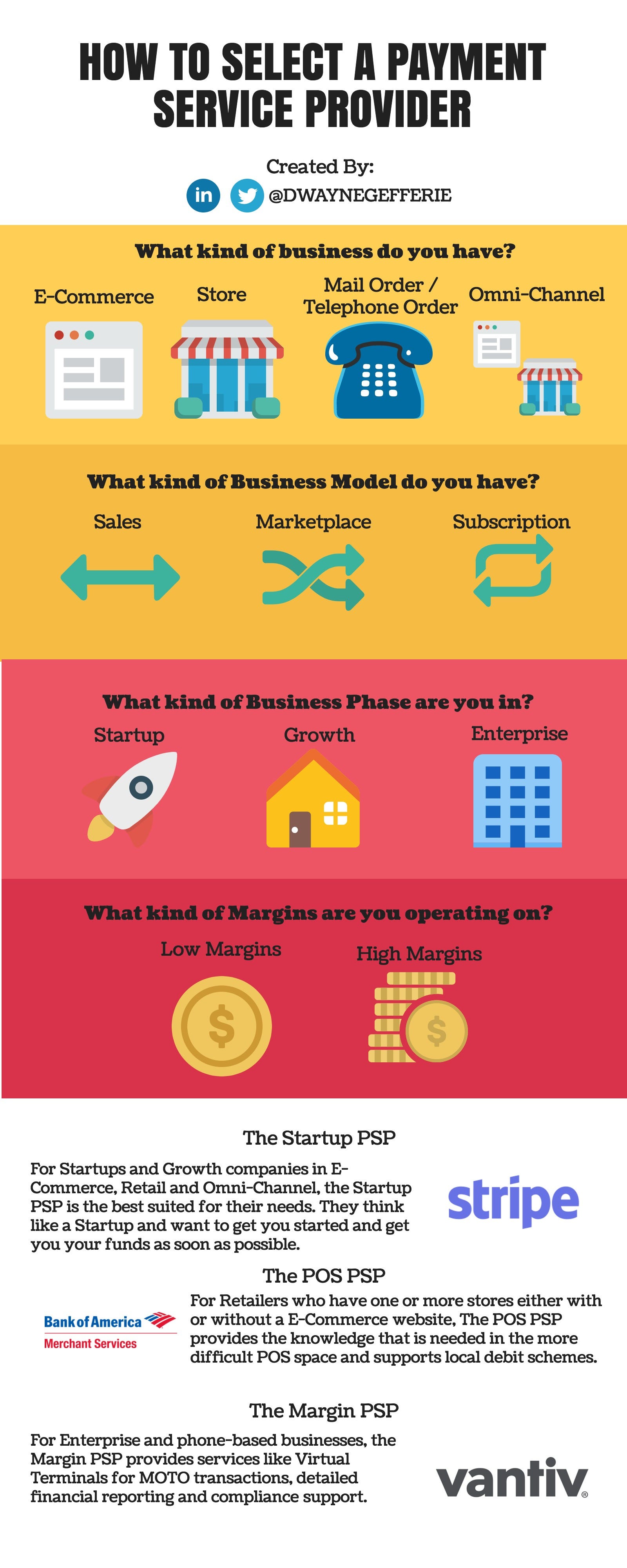One of the questions I get asked frequently, whenever I tell people I work in Payments is: “Which PSP should I use for my [insert business type] business?”
My Anwser…It depends on what you need.
Having worked with many merchants, I have yet to encounter a PSP (Payment Service Provider) that covers every company’s needs.

So how do you find the right PSP for your Business?
To answer that question, we have to answer the following questions first:
Question 1: What kind of Business Do You Have?
Question 2: What kind of Business Model Do You Have?
Question 3: Which Business Phase are you in?
Question 4: What kind of Margins are you operating on?
Question 1: What kind of Business Do You Have?
When it comes to selecting the right PSP, knowing what kind of business you have makes a lot of sense. First of all are you operating a Physical Store, an E-Commerce business, selling products or services over the Phone or Mail or are you combining both Online and Offline?
The main reason this is important, is because not all PSPs have the capabilities to support all four business types. With the emergence of E-Commerce, many E-Commerce-Only PSPs have been created, for example Stripe, Braintree and Checkout.com. Meaning that they only work with E-Commerce companies and are not able to support physical stores.
Most of the older PSPs, like Chase, Worldpay and First Data provide POS payment processing and have been adding E-Commerce to support their mostly enterprise merchants online activities, as well as merchants that still need Mail Order/Telephone Order Terminal capabilities.
Lately there have also been some mPOS PSPs emerging, who provide POS processing by using a Mobile Device, like iZettle, Square and Revel.
Question 2: What kind of Business Model Do You Have?
The Business Model you are using can have a great influence on the type of PSP that is most suitable for your company. If you are selling a product or service, your needs will be far different from a business that is selling subscriptions.
With one-off sales collecting data on your customer is far less important than when you are selling a subscription. Whenever you are sending a one-off transaction to your PSP, customer name and card details are the minimum requirements. Whereas with a Subscription, collecting a Billing Address, Shipping Address and additional information, are needed to authorize the first and collect on subsequent transactions.
With the emergence of alternative payment methods, we are seeing more hybrid payment collection methods. For example, the Dutch iDeal, is used to process the first payment in a subscription, and SEPA (Single European Payments Area) Transfers are used to collect funds on a recurring basis.
Question 3: What Business Phase are you in?
If you haven’t launched your product or service yet, you have a great idea but haven’t made a sale yet or just need a PSP that doesn’t ask a lot of questions, while you trying to figure stuff out, you are in the Startup Phase.
If however, you have been in business for several years, you have employees, you have revenue, maybe even some profits and sales are growing in the two to three digit numbers, you are in the Growth Phase.
In case you are a very established business, making hundreds of millions or even billions of dollars, growth can be projected with a lot of precision and your manager is asking you to evaluate the relationship with the current vendor, you are in the Enterprise Phase.
Question 4: What kind of margins are you operating on?
Even though this might seem like an odd question, margins can play a big role in your selection of a PSP based on the Pricing Model they use. The Blended Pricing model is the most used pricing model in the Payments industry, a fixed fee plus a percentage of the gross sale. Dependent on the PSP, the region and the accepted payment method, the fixed fee and percentage could range anywhere between 1% — 3% with a fixed fee ranging between $0.10 — $0.30. If you are running a business, which is operating on very slim margins of let’s say 10% gross profit. The impact of paying 3% and a fixed fee, would be the difference between making a profit or a loss.
Especially Enterprise companies who focus on large number of transactions, might opt to choose an Interchange++ pricing model. With Interchange++, merchants benefit from a higher level of transparency as far as the fees that are added by the PSP, the Acquirer, the Schemes and the Issuer. However this does add a level of analysis, to determine if the cost are actually lower than with blended pricing, due to higher fees with Corporate, Business and Premium cards.
So which one should you pick?
Now that you know which questions you should answer before you reach out to a PSP, how do you make sure you pick the right one?
There are hundreds of different PSPs but whenever selecting one, I break them down in the following three categories:
- The Startup PSP
- The POS PSP
- The Margin PSP
The Startup PSP
This category of PSP, is mostly associated with the Payments 2.0 type of PSP. Mostly focused on E-Commerce and instead of positioning themselves as a Financial Services company, they see themselves more as a FinTech or PayTech company. Using many of the same Product, Marketing and Valuation strategies as Tech companies, the Startup PSP, thinks, acts and works together with other Startups by making Payments as easy as possible and focussing on fast-integration, support and payouts. The best examples are Stripe and Checkout.com
The POS PSP
In the case you have a multiple physical stores and multiple POS terminals, the POS PSP is your best choice. The complexities of POS terminals is a major barrier of entry for a lot of new PSPs, which older PSPs have already figured out. As more retailers are integrating their E-Commerce with their physical stores, the POS PSPs are leveraging their experience or acquiring companies that bring in the necessary E-Commerce knowledge and tools. Some examples include: Bank of America Merchant Services, Ingenico and First Data.
The Margin PSP
For merchants that have small margins and large volumes of transactions, either as a Startup or Enterprise, The Margin PSP is the right choice. With the introduction of Interchange++, pricing has become extremely transparant. With Interchange++ comes detailed reporting and analytics, which gives merchants, the data to analyze the cost of each transaction. Besides Pricing, another focus of the Margin PSP is reducing Fraud and Chargebacks. Knowing that each transaction matters, the Margin PSP has developed extensive Fraud Detection capabilities, using Machine Learning and Rule-Based Logic to block possible fraudulent transactions. Margin PSPs include companies like Vantiv, Adyen and Braintree.
Compare, Implement, Analyze and Decide
So now that you know what to ask and what type of PSP you are looking for, I recommend comparing the features for at least 3 different PSPs.
Compare
Ask questions like;
- What are the fees?
- How often do they payout?
- How many currencies can they process in?
- Do they support Alternative Payment Methods?
And any questions that are relevant for your business.
Implement
After you asked all the necessary questions and you have narrowed down your selection even more, I would recommend to implement at least 2 different PSPs and see how they compare in performance. Use your Test-Account to see how it works with your application and if you have been issued a Live-Account, process live transactions and see if it works as expected.
Analyze
After you tried as many payments as possible, analyze the reporting you receive. Check Authorization Rates, Conversion Rates, Fees and the feedback you receive from people outside of the developers and product managers.
Decide
Finally, decide on which one you want to work with.
I hope this overview helps you to find the PSP that best suits your needs.
As an added bonus I created an infographic, as a visual aid to which questions you should ask and what type of PSP you should reach out to.


